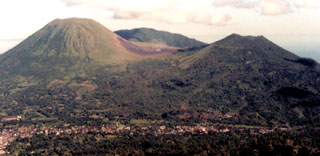Report on Lokon-Empung (Indonesia) — November 2011
Bulletin of the Global Volcanism Network, vol. 36, no. 11 (November 2011)
Managing Editor: Richard Wunderman.
Lokon-Empung (Indonesia) Ongoing minor ash-bearing eruptions through at least November 2011
Please cite this report as:
Global Volcanism Program, 2011. Report on Lokon-Empung (Indonesia) (Wunderman, R., ed.). Bulletin of the Global Volcanism Network, 36:11. Smithsonian Institution. https://doi.org/10.5479/si.GVP.BGVN201111-266100
Lokon-Empung
Indonesia
1.3644°N, 124.7992°E; summit elev. 1580 m
All times are local (unless otherwise noted)
Lokon-Empung has been in a state of unrest since 2007 (BGVN 33:02). Between mid-February through mid-July 2011, occasional phreatic eruptions, modest ash plumes and elevated seismicity occurred, with a larger ash plume in July 2011 (BGVN 36:06). This report addresses seismic events from mid-July through 1 December 2011.
According to the Center of Volcanology and Geological Hazard Mitigation (CVGHM), during 20-21 July 2011, seismicity and visual observations of Tompaluan crater in the saddle between the twin peaks of Lokon and Empung indicated that activity continued to be high. On 20 July plumes rose 100-500 m above Tompaluan crater, and during 21-24 July 2011 white plumes again rose 100-300 m. CVGHM noted that, since an eruption on 18 July, most data showed a decline in activity and therefore on 24 July the Alert Level was lowered to 3 (on a scale of 1-4). Residents and tourists were not permitted within 3 km of the crater. A news article (Straits Times) stated that on that same day about 5,000 residents that had evacuated returned home, and about 200 people remained in shelters.
CVGHM reported that during 24 July-8 August 2011 seismicity decreased at Tompaluan crater, with a drastic reduction on 26 July. According to a news article (BNO News, accessed on Daijiworld News), during 27 July-8 August white plumes rose 100-400 m above the crater. The article stated that at the end of August, Tompaluan crater erupted several times (12 times on 28 August). One explosion on 29 August 2011 ejected material 250 m above the crater. According to the article, activity decreased after 29 August. The article also noted that 222 people remained at temporary refugee camps because their homes were located within 3 km of the crater.
CVGHM reported that on 10 October 2011 white and gray plumes rose 100-300 m above Tompaluan crater. Based on information from CVGHM, the Darwin Volcanic Ash Advisory Centre (VAAC) reported that on 11 October an ash plume rose to an altitude of 2.1 km.
According to a news article (Kompas.com), a gray plume rose 1.2 km above Tompaluan crater and drifted SW on 26 October, followed by an explosion that sent incandescent material as far as 800 m away from Tompaluan crater. A second eruption produced a plume that rose 500 m above the crater.
Geological Summary. The Lokong-Empung volcanic complex, rising above the plain of Tondano in North Sulawesi, includes four peaks and an active crater. Lokon, the highest peak, has a flat craterless top. The morphologically younger Empung cone 2 km NE has a 400-m-wide, 150-m-deep crater that erupted last in the 18th century. A ridge extending 3 km WNW from Lokon includes the Tatawiran and Tetempangan peaks. All eruptions since 1829 have originated from Tompaluan, a 150 x 250 m crater in the saddle between Lokon and Empung. These eruptions have primarily produced small-to-moderate ash plumes that sometimes damaged croplands and houses, but lava-dome growth and pyroclastic flows have also occurred.
Information Contacts: Center of Volcanology and Geological Hazard Mitigation (CVGHM), Jalan Diponegoro 57, Bandung 40122, Indonesia (URL: http://www.vsi.esdm.go.id/); Darwin Volcanic Ash Advisory Centre (VAAC), Bureau of Meteorology, Northern Territory Regional Office, PO Box 40050, Casuarina, NT 0811, Australia (URL: http://www.bom.gov.au/info/vaac/); Straits Times (URL: http://www.straitstimes.com); BNO News (URL: http://www.bnonews.com/); Kompas.com (URL: http://www.kompas.com/); Antara News (URL: http://www.antaranews.com/en/); Daijiworld News (URL: http://www.daijiworld.com/).

